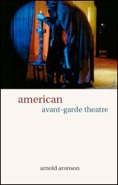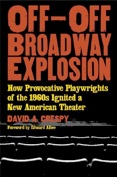Igniting the Stage:
Experimental Theatre in America
American experimental theatre was born in response to the questions of the nuclear age that began to challenge theatre artists in the years following World War II. Faced with the unknowns of this new world, and influenced by the philosophies of Gertrude Stein and John Cage, playwrights, actors, and directors developed alternative forms of expression that subverted the norms of American Stanislavski-based realism and mainstream Broadway popular theatre.
While the Off-Broadway movement prior to the war gave birth to seminal playwriting voices such as Eugene O’Neill, the radical American avant-garde was not firmly established until Julian Beck and Judith Malina founded the Living Theatre in 1946. Beck and Malina engaged in a new style of meta-theatricality that called attention to the theatre process and questioned the traditional Aristotelian emphasis on plot. In works such as The Connection (1959), the Living Theatre abandoned traditional narrative devices and devalued language in theatrical performance. Physical gesture, improvisation, and an Artaud-inspired theatre of cruelty took the place of plot, character, and the dialogue of realism. Ellen Stewart’s La MaMa Theatre (1961), the San Francisco Mime Troup (1959), and The Judson Poets’ Theatre (1961) were among the other influential experimental theaters established during these early years.
Established in 1968, Joseph Chaikin’s Open Theatre gave birth to a new communal theatre and method of acting training based in physical improvisation, political awareness, and theatre games. Playwright Jean-Claude Van Itallie’s The Serpent opened at the Open Theatre in 1968 and contained movement-based scenes ranging from Adam and Eve in the Garden of Eden to a frame by frame recreation of the Kennedy assassination.
Like the Open Theatre, much of American experimental theatre in the 1960s and 1970s was fueled with a mission to address political and cultural realities. Founded in 1965, Luis Valdez’s El Teatro Campesino used commedia based and politically charged improvisational theatre to speak to issues affecting the Mexican-American community. In works such as Zoot Suit (1978) and Los Vendidos, Valdez challenged stereotypes and spoke to issues of identity that confronted Mexican-Americans. African-Americans experimented with alternative theatrical expression as well, forming groups such as the Negro Theatre Ensemble (1968). Amiri Baraka’s play Dutchman (1964) was controversial for its militant perspectives on race relations and frank discussion of sexuality. Numerous feminist theaters were born in this era, such as The Women’s Experimental Theatre, which explored issues specific to women, such as domestic violence and rape.
Postmodern deconstructions of language and culturally accepted norms influenced the work of experimental theater groups such as Mabou Mines and The Wooster Group. Solo performance artists Robert Wilson deconstructed classic texts in monologue performances. Anna Deveare-Smith and John Leguizamo are among dozens of solo performance artists that continue to explore experimental performance in the new millennium.
--Andrew Carlson
Sources and further reading:
Aronson, Arnold. American Avant-Garde Theatre: A History. London: Routledge, 2000.
Chaikin, Joseph. The Presence of the Actor. New York: McClelland and Stewart Lmt., 1972.
Crespy, David. Off-Off Broadway Explosion. New York: Backstage Books, 2003.
Living Theatre Website. http://www.livingtheatre.org/
San Francisco Mime Troupe Website. http://www.sfmt.org
Shank, Theodore. American Alternative Theatre. New York: Grove Press Inc., 1982.





